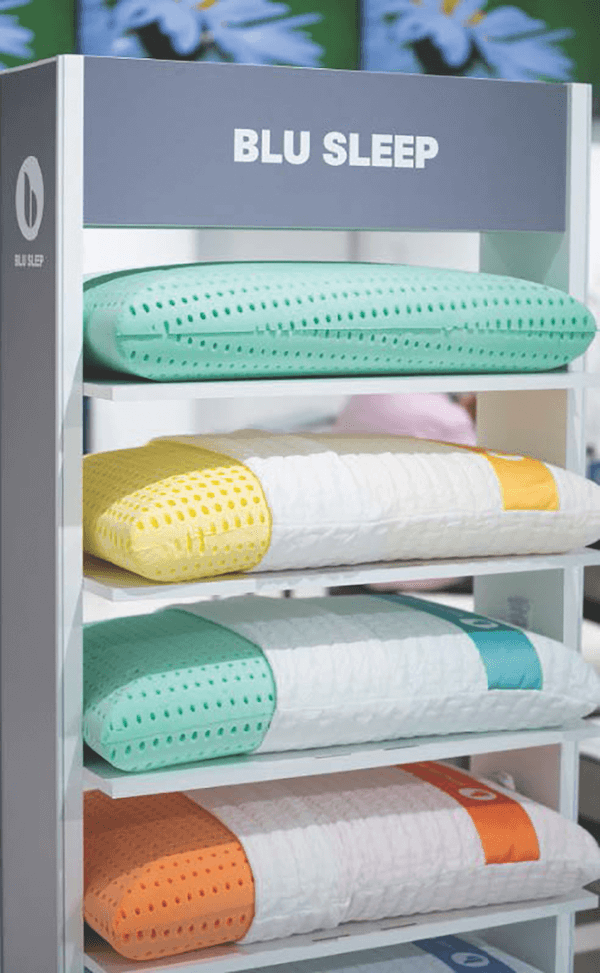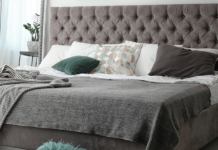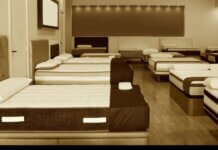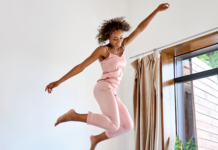While economic uncertainty has cast a shadow throughout the year, there is a bit of…
Maximize Pillow Sales: In-Store Strategies for Success
Here are some practical ways you can increase pillow sales at your brick-and-mortar locations. Be sure to check out our feature on “The Value Proposition of Pillows” to get a solid understanding of this product and what increased sales can do for your bottom line.
Merchandising
Pick the Right Lineup
Too many pillow choices “give the end consumer analysis paralysis,” says Jesse Gibbs, vice president of national sales for Malouf Home, a sleep products source with headquarters in Logan, Utah. “Customers are lost because there are too many options. We recommend a clean, concise lineup with variety, but not an overwhelming amount of options.”
Carpenter Co.’s Ken Brown says retailers also sometimes hamper rather than help pillow sales by offering too many similar products “at retail prices that don’t match the value of each pillow.”
“If you don’t give the consumer a reason to step up in price, they will ultimately not do it,” says Brown, vice president of sales for the consumer products division at the Richmond, Virginia-based company. “Then it becomes a race to the bottom, or how cheap can you sell something to get them to buy it.”
Look For More Than a Pretty Package
When choosing pillow vendors, Brown suggests paying careful attention to the producer’s packaging. “Another misstep is not having the packaging focus on the best or most compelling selling features, no matter the price point. What’s going to help the customer make that ultimate decision? Is it thread count, the brand, warranty? Or is it emphasizing the solution-based selling features and benefits? It’s the ‘why buy’ that truly matters,” he says.
Carpenter develops its pillows based on “true sleep needs,” Brown says, and then designs packaging that makes those “innovative materials and constructions” understandable to a consumer, whether a retail sales associate is available to help them select a pillow or not. “Without the proper packaging message, products will get lost, especially value-add products that offer a wide range of features and benefits,” he adds.

Create an Inviting Display
Blu Sleep and Malouf are among the pillow sources that offer branded displays for their pillows and other bedding accessories, or you can create your own displays. Whichever option you choose, the key is to create an inviting destination that attracts attention and makes it easy for shoppers to compare and test pillows.
Bundle Up
Packaging and selling pillows with other items — from mattress protectors to sheets to other linens — increases the average sales ticket and helps customers build a complete bed ensemble. Malouf helps retailers by offering “a cooling bundle, natural bundle, deluxe bundle and value bundle, and we customize the product based on (a retailer’s) lineup,” Gibbs says.
Education
Focus on The Most Useful Information
Retailers should give RSAs the training and information they need to explain pillow profiles, shapes, components and constructions to consumers, says Elizabeth Dell’Accio, president of Blu Sleep, a producer of a full line of sleep products based in Pompano Beach, Florida. Educational signage, product testing stations and other tools can supplement that RSA training and give shoppers additional information they need to make the right decision for them.
Gibbs agrees product education is important. “We’ve invested in different training materials so RSAs have everything they need to understand the features and benefits of our pillows,” he says. “Our sales team and sales reps also work closely with our retail partners to set them up for success every step of the way.”
Sales Strategy
Make an Early Introduction
One mistake brick-and-mortar retailers sometimes make is to consider pillows an afterthought, Gibbs says. “Retailers may not talk about the entire sleep experience, and they don’t bring up the accessories or the essentials early and often in the conversation,” he says.
“… We always recommend talking about the complete sleep experience, and how a pillow is so important to a good night’s sleep. The pillow is a crucial piece and makes up 30% of the overall sleep experience.” Retailers who sell a lot of pillows typically start the bed rest-testing process not at the mattress array but at the pillow display.
Assess Their Position
Many sleepers benefit from a pillow designed to match their preferred sleeping position: back, side or stomach. So, start by asking shoppers about that, pillow makers say. Blu Sleep has found that most side sleepers prefer medium- to high-profile pillows roughly 5½ inches to 6 inches thick, Dell’Accio says. Back and stomach sleepers, she says, typically rest more comfortably on a low-profile pillow that’s roughly 4½ inches to 5 inches thick.
Ask the Right Questions
“The best way for an RSA to help a customer choose the right pillow is through an informative and consultative approach,” Gibbs says. In addition to asking about a preferred sleeping position, RSAs should determine shoppers’ other needs. Do they sleep hot and flip their pillow over throughout the night? Do they have allergies? Do they want a pillow they can launder often?
Test It Out
Once shoppers choose a pillow they like, have them carry it with them as they try different mattresses. The consistency limits the number of variables they need to consider when rest-testing and helps them bond with the pillow, increasing the chances that they’ll want to buy it along with the bed. Be sure to keep disposable covers on hand so each shopper has a fresh, hygienic surface for their head.




